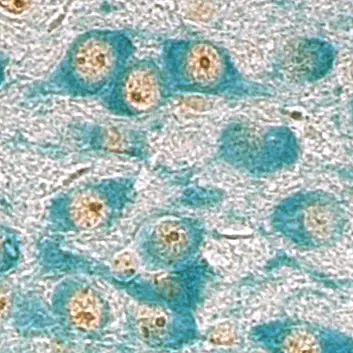“Nucleolus", or small nucleus, is the term coined by early biologists for the tiny structure within the nucleus which they saw under the microscope. In this structure within the nucleus, RNA molecules and proteins are assembled to form ribosomes, the true protein factories of cells.
Defective nucleoli have been implicated in several rare hereditary diseases, most recently also in neurodegenerative disorders such as Alzheimer’s and Huntington’s disease. Despite intense research efforts around the world, the molecular causes of Parkinson’s disease are still unclear. Under the leadership of Dr. Rosanna Parlato, scientists from the departments of Professor Dr. Guenther Schuetz and Professor Dr. Ingrid Grummt at DKFZ have investigated whether the demise of nucleoli also plays a role in this disease, which is also known as “shaking palsy".
The investigators studied dopamine-producing neurons in the brain of Parkinson’s disease patients under the microscope. When Parkinson’s disease occurs, this type of cells malfunctions and dies, causing the characteristic palsy symptoms. Indeed, the majority of nucleoli in these cells were found to be defective.
This discovery caused the group to investigate whether disrupted nucleoli may really cause Parkinson’s-like symptoms or whether this was only an incidental finding. To this end, they modified the DNA of mice in such a way that the dopamine-producing cells of the experimental animals could only form defective nucleoli. These mice showed symptoms resembling Parkinson’s disease, such as characteristically impaired movements. In addition, the dopamine-producing neurons in their brain died prematurely.
In order to find out why these symptoms occur, the researchers took a closer look at all functions of the genetically modified cells. And they found an important change: The activity of the mTOR enzyme, a key regulator of intracellular signaling pathways, was reduced in the genetically modified cells. As a result of reduced mTOR activity, the function of mitochondria, the cellular power plants, is disrupted. This functional disruption causes oxidative stress within the cell; highly reactive oxygen compounds accumulate and cause damage to a multitude of molecules in the cell.
“Defective nucleoli apparently cause oxidative stress in cells. This can lead to massive cell damage and may be a key prerequisite for the typical nerve damage of Parkinson’s disease," says Dr. Rosanna Parlato. “The dopamine-producing neurons are particularly sensitive to oxidative stress." However, the scientists are not sure whether the damage in the nucleoli is really the sole cause of this neurodegeneration. “In any case, the nucleolus functions as a stress sensor showing us that a cell is in danger."
Claus Rieker, David Engblom, Grzegorz Kreiner, Andrii Domanskyi, Andreas Schober, Stefanie Stotz, Manuela Neumann, Xuejun Yuan, Ingrid Grummt, Günther Schütz and Rosanna Parlato: Nucleolar Disruption in Dopaminergic Neurons Leads to Oxidative Damage and Parkinsonism through Repression of Mammalian Target of Rapamycin Signaling. The Journal of Neuroscience, January 12, 2011, 31(2):453– 460
About DKFZ
With more than 3,000 employees, the German Cancer Research Center (Deutsches Krebsforschungszentrum, DKFZ) is Germany’s largest biomedical research institute. DKFZ scientists identify cancer risk factors, investigate how cancer progresses and develop new cancer prevention strategies. They are also developing new methods to diagnose tumors more precisely and treat cancer patients more successfully. The DKFZ's Cancer Information Service (KID) provides patients, interested citizens and experts with individual answers to questions relating to cancer.
To transfer promising approaches from cancer research to the clinic and thus improve the prognosis of cancer patients, the DKFZ cooperates with excellent research institutions and university hospitals throughout Germany:
- National Center for Tumor Diseases (NCT, 6 sites)
- German Cancer Consortium (DKTK, 8 sites)
- Hopp Children's Cancer Center (KiTZ) Heidelberg
- Helmholtz Institute for Translational Oncology (HI-TRON Mainz) - A Helmholtz Institute of the DKFZ
- DKFZ-Hector Cancer Institute at the University Medical Center Mannheim
- National Cancer Prevention Center (jointly with German Cancer Aid)
The DKFZ is 90 percent financed by the Federal Ministry of Research, Technology and Space and 10 percent by the state of Baden-Württemberg. The DKFZ is a member of the Helmholtz Association of German Research Centers.



